|
Undoubtedly, Europe is filled with destinations and experiences that would make anyone’s bucket list. The continent’s rich history means that it is filled with historical landmarks, beautiful art galleries, and architecture. Whether it’s the ceiling in the Sistine Chapel, or Edvard Munch’s ‘The Scream’ in Norway, the beauty of these pieces of history and culture must be seen to be believed.
Add to this, the variety of different landscapes, languages, and cultures, and Europe becomes a traveller’s paradise. If it’s your first time to Europe, or you’re making a return visit because ‘once just wasn’t enough’, let LeShuttle help you plan your ultimate European bucket list adventure.
Planning your road-trip
Frequently ‘take a road trip’ also appears on many people’s bucket lists. While you can easily visit different European cities individually and stay for as long as you like, one of the best things about Europe is how easy it is to travel between the different countries. Road-tripping means you can see and explore different communities and destinations at your leisure, rather than on an airline or train company’s timetable.
Plus, so many European countries have historic connections, that being able to travel from one to another in one trip helps to create a sense of just what a well-woven history the continent has.
 Tick a road-trip around Europe off your bucket list
Tick a road-trip around Europe off your bucket list
Bucket list destinations you mustn’t miss
Whether you want beaches, beers, or beauty, Europe is full of different countries, all of which have something ‘unmissable’ for you to see or do. That being said, there are a few destinations that should be at the top of anyone’s bucket list.
France
A world leader in terms of cuisine, music, fashion, wine-making, and art, the first destination on your European bucket list has to be France. It’s also the first country you arrive in when driving to Europe from the UK. From our Folkestone terminal, you can be in Calais in 35 minutes, and ready to start your adventure. Not only is driving to France quicker than many other forms of transport, but it also means you’ll be able to bring as much (or as little) as you like for your road-trip.
The Eiffel Tower, Paris
Within 3 and a half hours from our Calais terminal, you’ll arrive in the sparkling city of Paris. With a reputation for being one of the most romantic and cultural cities in the world, there are plenty of sites and spots for you to see.
Synonymous with Paris, the first landmark to tick off your bucket list has to be the Eiffel Tower. Built between 1887 and 1889, the tower was originally meant to serve as an entrance gateway to the International Exposition of 1889. Named after the engineer Gustave Eiffel, it is also a testament to French industrial ingenuity. Often lit up to mark different world events, the Eiffel Tower is a popular spot for tourists to visit at night. Visiting this iconic monument at sunrise is also a great way to kick-start your day in Paris and avoid crowds.
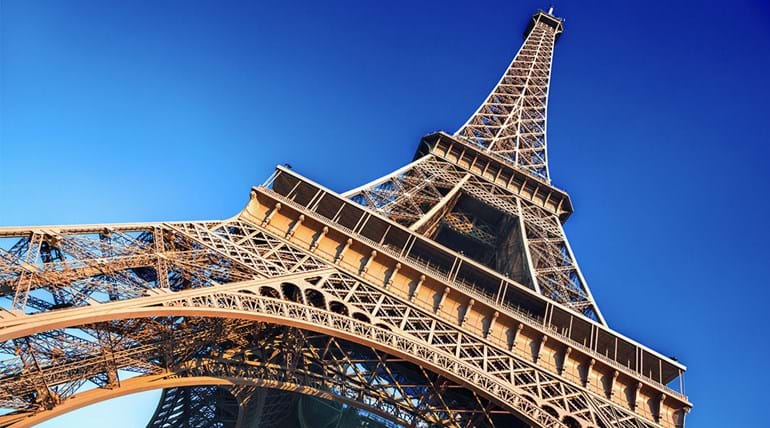 See the intricacies of the Eiffel tower’s construction for yourself
See the intricacies of the Eiffel tower’s construction for yourself
Arc de Triomphe, Paris
Standing at the centre of the Place Charles de Gaulle, the next landmark to visit has to be the Arc de Triomphe. Located at the western end of the Champs-Élysées, the Arc de Triomphe is a symbol of French national identity and took 30 years to build.
Inspired by the great arches of antiquity, if you have time, you can purchase tickets to go up the arc where you’ll be rewarded with an incredible view across the city. The final day of the Tour de France also concludes with a lap around the Arc de Triomphe, so if you’re planning a trip in July, it’s well worth trying to take in this astounding site.
Verdon Gorge
Sadly it’s time to leave Paris and head across the country to Verdon Gorge, the deepest gorge in France and one of the must-see natural wonders in Provence.
The drive to Verdon Gorge will take just over 9 hours, however, during this time you will also go through Lyon and Valence. Although they didn’t make our ‘ultimate European bucket list’, both places are wonderful in their own right and ideal points for you to stop and break your journey.
Once you do reach Verdon Gorge, you’ll be able to stretch your legs on one of the many hiking trails that surround the turquoise blue water. You can also try kayaking, swimming, or paddle boating on the River Verdon, which will give you an incredible view of the cliffs that surround the gorge itself.
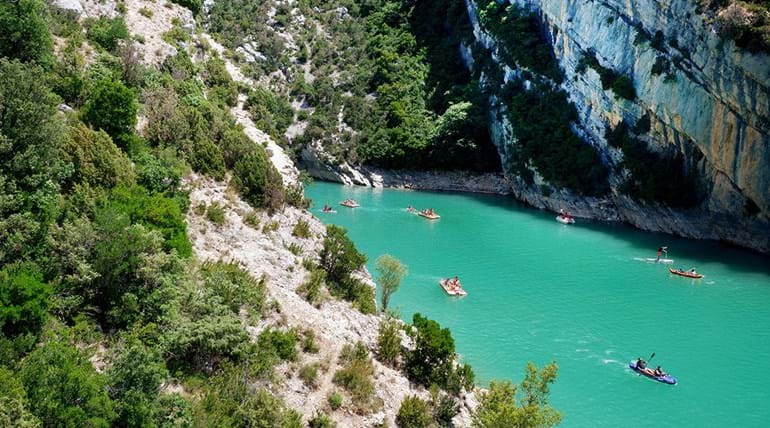 Get active at Verdon Gorge
Get active at Verdon Gorge
Dunes of Pilat
While it’s worth spending a few days at Verdon Gorge so you can truly make the most of its beauty, when it is time to move on you won’t be disappointed by your next bucket list destination.
The Dunes of Pilat, located in La Teste-de-Buch are around an 8-hour drive from Verdon Gorge. Although this is another lengthy drive, it does also give you the chance to stop and explore Toulouse on your way.
Once you reach the Dunes of Pilat, it’s time to stretch your legs again. As the tallest sand dune in Europe, hiking to the top is an experience you won’t forget. Generally, the walk takes around an hour and a half, but the view from the top (plus the endorphins) is a great reward. Fortunately, the trip down is much easier thanks to gravity. By descending the dune, you also have the option to walk back along the shore and enjoy a sea breeze and more wonderful views of the coast.
Belgium
For the next stop on your European bucket list adventure, it’s off to Belgium!
Situated in the West of Europe, Belgium is the country of canals, wonderful gardens, and even more wonderful waffles and chocolate. For this stretch of your road-trip, we hope you have brought your appetite, as well as your appreciation for all things historical, cultural, and aesthetically pleasing.
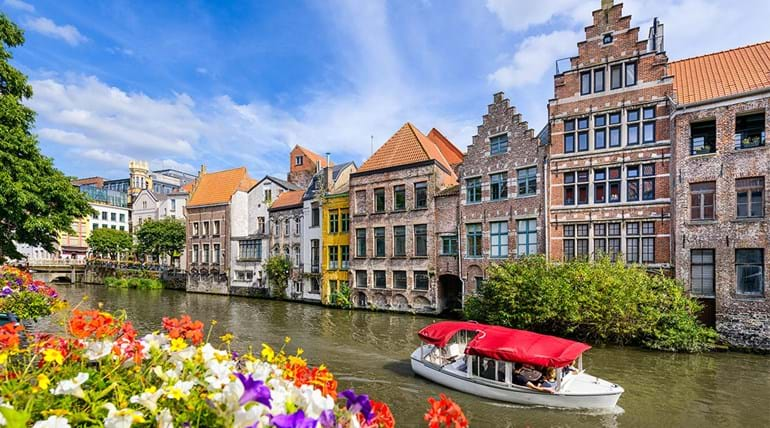 Make sure you add Belgium to your European bucket list
Make sure you add Belgium to your European bucket list
La Grand Place, Brussels
First, it’s time to head to Brussels. Known as ‘The capital of Europe’, Brussels is the seat of the EU and has the status of a global city. La Grand Place is the city’s central square and is considered to be one of the most beautiful squares in the world.
Originally an 11th-century marketplace, La Grand Place is surrounded by the Guild houses, City Hall, and Maison du Roi. It was added to the UNESCO World Heritage List in 1998 and has continued to be a popular spot for visitors to the city. If you’re in Brussels in August, make sure you visit La Grand Place to see the Flower Carpet, a tapestry-like display of begonias. The artistry and creativity (not to mention the smell) make it truly unmissable.
Atomium, Brussels
Once you’ve had your fill in La Grand Place, it’s time to visit another Belgium landmark in the city of Brussels, the Atomium. Initially conceived as a temporary monument, the Atomium was constructed to be used as the main pavilion for the 1958 Brussels World’s Fair. Following its popularity, the Atomium has since become the symbol of Brussels and Belgium.
Representing an iron unit cell that has been magnified 165 billion times, the Atomium’s unique silhouette makes it easy to spot. Inside it’s just as fascinating, with an interior design often likened to a spaceship. You can buy tickets to explore the Atomium, and we thoroughly recommend you do, as the views from the panorama are unbelievable.
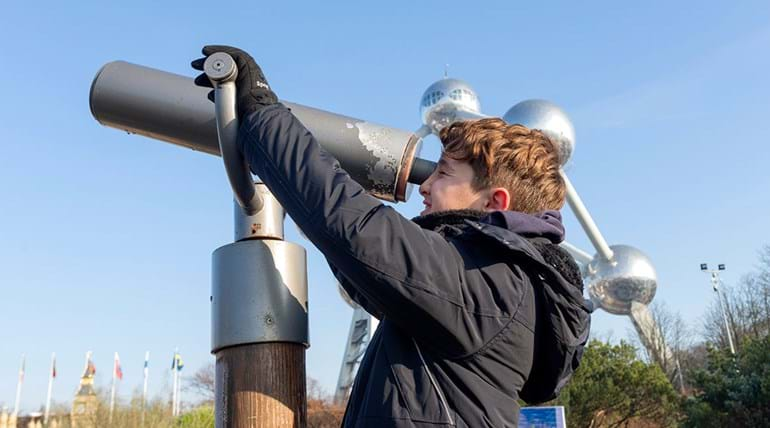 Inside or out, the Atomium is an incredibly impressive landmark
Inside or out, the Atomium is an incredibly impressive landmark
Gravensteen Castle, Ghent
Although it would be easy to spend an eternity in Brussels, the next destination on your European adventure awaits. This time, you’re heading off to Ghent, which driving from Brussels takes just under an hour on the E40.
When you reach Ghent, the first thing to do is visit Gravensteen Castle, which dates back to 1180. This medieval castle has an extremely turbulent past, having been used as a court, prison, mint, and cotton factory throughout different periods in history. Also known as the ‘Castle of the Counts’, if you want to get an overview of the history and culture of Flanders, Gravensteen Castle is the place.
The Last Post at the Menin Gate
If you drive an hour away from Gravensteen Castle to Ypres, you’ll arrive at the Menin Gate, a war memorial dedicated to the British and Commonwealth soldiers who died in the Ypres Salient of World War I and whose graves are unknown.
Since 1st May 1929, the last post has been sounded at 8pm every night at the Menin Gate. This tribute to the soldiers who fought and died in Flanders is extremely moving, and something to be heard if you get the chance.
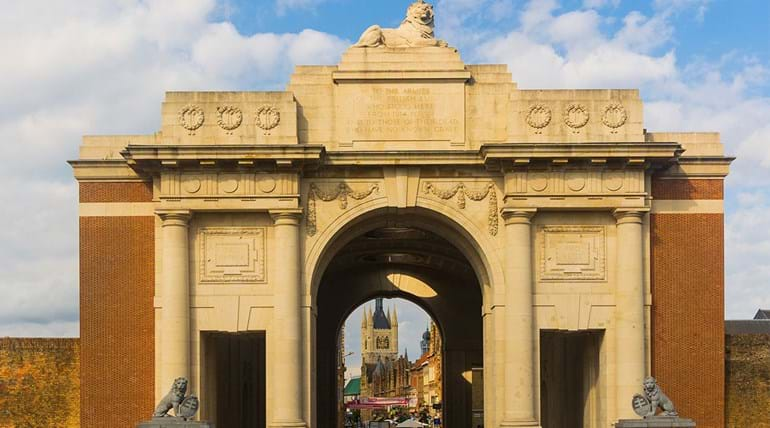 The Menin Gate is a poignant tribute to the thousands of soldiers who lost their lives in World War I.
The Menin Gate is a poignant tribute to the thousands of soldiers who lost their lives in World War I.
The Netherlands
Sandwiched between Belgium and Germany, the Netherlands is another Western European country with a lot to offer locals and visitors alike. Home to more than 17 million people, there’s plenty packed into a relatively small country (the Netherlands is just over 41,000 square km), and lots to tick off your bucket list.
The Cube Houses, Rotterdam
The first port of call when you reach the Netherlands (or more specifically Rotterdam), is to go and see the iconic cube houses. Designed by architect Piet Blom, these bright yellow houses are cubes tilted over by 45 degrees to optimise the use of the space inside.
Not only are the cube houses unmissable from the street, but you can learn more about the apartments in the Show Cube Museum. For really curious visitors who want to get a taste of the space themselves (trust us when we say it’s unlike anywhere else in the world), the development also has a hostel where you can spend the night.
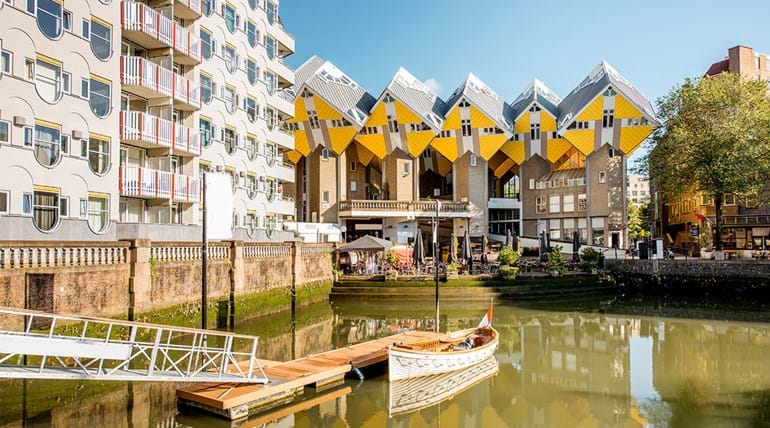 Fancy a night in one of Rotterdam’s Cube Houses?
Fancy a night in one of Rotterdam’s Cube Houses?
Van Gogh Museum, Amsterdam
From quirky cubes to the vibrancy of Van Gogh’s work, the next location on your tour through the Netherlands is the Van Gogh museum in Amsterdam.
Located in Museum Square in Amsterdam South, the Van Gogh museum is home to the largest collection of the artist’s work in the world. Comprising more than 500 drawings, 200 paintings, and 700 letters, the museum acts as a window into Van Gogh’s life as well as a place to view his art.
Recommended visit times are between 90 minutes to two and a half hours, giving you enough time to explore the permanent collection and any exhibitions also being held. Works included in the permanent collection are ‘Sunflowers’, ‘Self-portrait with a Grey Felt Hat’, plus ‘Wheatfield with crows’. For art lovers in particular, a trip around the Van Gogh museum is most definitely something to experience for yourself.
Visit the tulip farms
The Netherlands is famous for being the largest flower exporting country in the world. They produce 80% of the world’s flower bulbs, and 90% of the world’s tulip farms are in the Netherlands. Unsurprisingly, the tulip is the Dutch national flower, and every year National Tulip Day is celebrated on the third Saturday in January.
If you want to see these famous fields for yourself, we recommend visiting Keukenhof Tulip Gardens, a 30 minute drive from the centre of Amsterdam. There are numerous tulip fields surrounding the Gardens, which are open during the tulip season. The best time to visit the tulip fields and farms is in April or May when most of the flowers are in bloom. If you’re looking for a way to celebrate the start of spring in style, there’s no better way than a trip to the tulip farms.
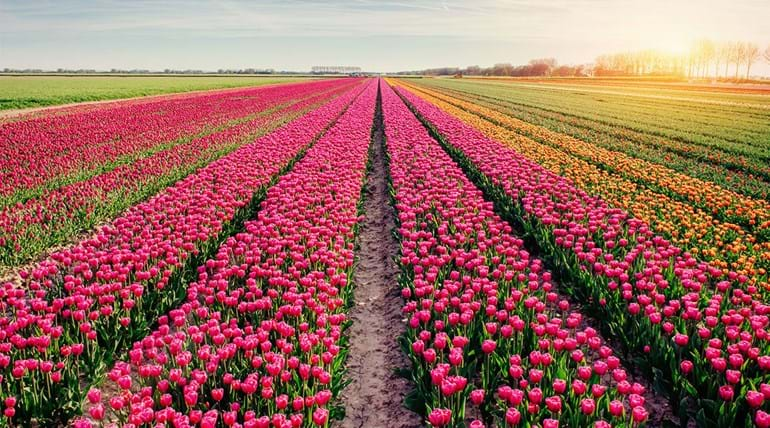 Take a walk through the beautiful tulip fields in Amsterdam
Take a walk through the beautiful tulip fields in Amsterdam
Germany
The penultimate country on your road-trip around Europe is Germany. As well as being the birthplace of classical music and philosophy, Germany is also known for its engineering and automotive industry, as well as its scenic beauty and rich history.
The Berlin Wall
A huge part of Germany’s modern history was the construction of the Berlin Wall during the Cold War in 1961. The wall was a guarded concrete barrier, put in place by the East German government to separate West Berlin from East Berlin. However, rather than separating the different areas, the wall served to encourage mass defections from East to West Berlin.
The wall was demolished in 1989, and the ‘opening of the iron curtain’ was a pivotal event in world history. Today remains of the infamous concrete barrier are still there, and anyone visiting the city can stop and take a moment to appreciate this piece of the past. You can also take a guided tour of the Berlin Wall or visit the official Berlin Wall Memorial at Bernauer Strasse. We would also recommend a visit to ‘Checkpoint Charlie’, the most famous crossing point between East and West Berlin, which is still there today.
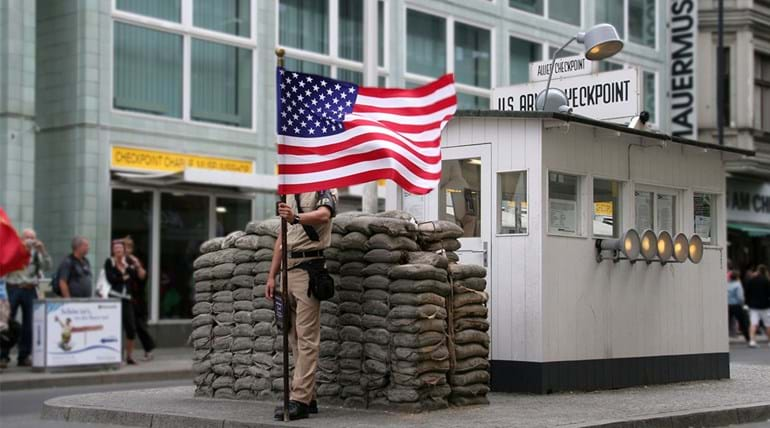 Checkpoint Charlie was once the most famous border crossing point between East and West Berlin
Checkpoint Charlie was once the most famous border crossing point between East and West Berlin
Brandenburg Gate, Berlin
Another piece of Cold War history is the Brandenburg Gate, which became part of the Berlin wall in 1961. When the wall fell, the gate became a symbol of the reunification of Germany, and of European unity and peace.
An 18th-century neoclassical monument, the Brandenburg gate was built on the orders of Prussian king Frederick William II on the site of a former city gate. Today it is one of the most iconic sites in Berlin and a must-see for anyone visiting the city.
Oktoberfest, Munich
For anyone travelling in September and October, it’s off to Munich for Oktoberfest! Held annually in Bavaria, Oktoberfest is the world’s largest Volksfest, featuring the famous beer festival and a travelling carnival.
Since its origin in 1810, the whole festival has grown into a massive celebration where locals and tourists alike can enjoy dressing up, sampling some of the local breweries’ best beers, and enjoying popular dishes like kasespatzle, wurst, and gingerbread. Again, spending a day or more at Oktoberfest definitely constitutes an unmissable bucket list item.
 Tick ‘try locally brewed German beer’ off your bucket list
Tick ‘try locally brewed German beer’ off your bucket list
Visit German Christmas Markets
For anyone working their way across Europe during winter, another item to add to your bucket list has to be a visit to one (or two) of the German Christmas markets. Spread across the country, these authentic markets are incredibly charming, and a great way to get in the Christmas spirit. The festive atmosphere is infectious, and not something that can truly be conveyed other than in person.
Further afield
Why stop in Germany? As we said before, planning a road-trip around Europe really does mean that the places you can visit are unlimited.
St Peter’s Basilica, Rome
If you’re keen to explore Italy but unsure where to begin, then might we suggest St. Peter’s Basilica in Rome?
The Basilica is traditionally the burial site of the titular St. Peter and is known as one of the holiest sites of Christianity and the Catholic tradition. Visitors can enter for free (although beware that the lines can be long), and marvel at just how vast the space inside the Basilica is. You can also take a tour of the Cupola, the beautiful dome which offers an astounding view of the nave and the altar, as well as across the Piazza San Pietro.
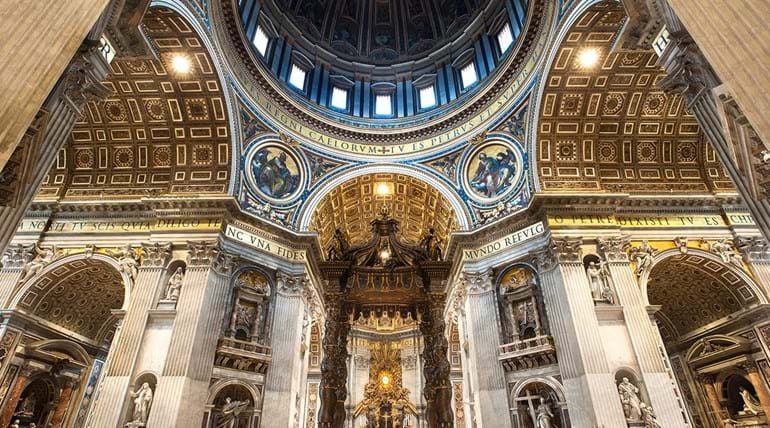 Step inside St. Peter's Basilica
Step inside St. Peter's Basilica
Sagrada Familia, Barcelona
Alternatively, why not head to Barcelona and visit the Sagrada Familia? This famously unfinished church is in the Eixample district and is one of the most well-known examples of Antoni Gaudí’s unique style. Work to complete the Sagrada Familia is still ongoing, but you can still visit during the construction process and explore the towers, basement, and museum.
Charles Bridge, Prague
If you’re in the mood for some more architectural landmarks and monuments, definitely go to Prague. Along with the Dancing House, St Astronomical Clock, and Powder Tower, Prague is also famously home to the Charles Bridge. Not only is it the oldest bridge still standing over the Vltava river, but it is also the second oldest bridge in the Czech Republic after being built by Charles IV in 1357. Taking 45 years to complete, and 10 minutes to walk across, the Charles Bridge is a wonderful landmark to visit for anyone travelling to Prague.
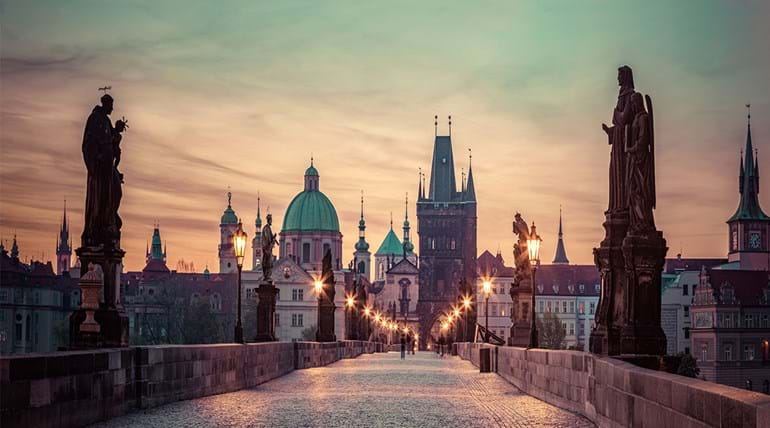 If you’re ever in Prague, take a walk across Charles Bridge
If you’re ever in Prague, take a walk across Charles Bridge
Amalfi Coast, Italy
For some rest and relaxation, make sure you add the Amalfi Coast to your European bucket list. Stretching 50km along the southern edge of Italy, the Amalfi Coast is filled with secret beaches, vineyards, and picturesque towns complete with colourful, winding streets.
If you have just completed a road-trip across Europe, we can think of no better place to relax and unwind than on the Amalfi Coast.
Start your bucket list adventure with LeShuttle
The world is your oyster! Start your bucket list adventure with LeShuttle.
|